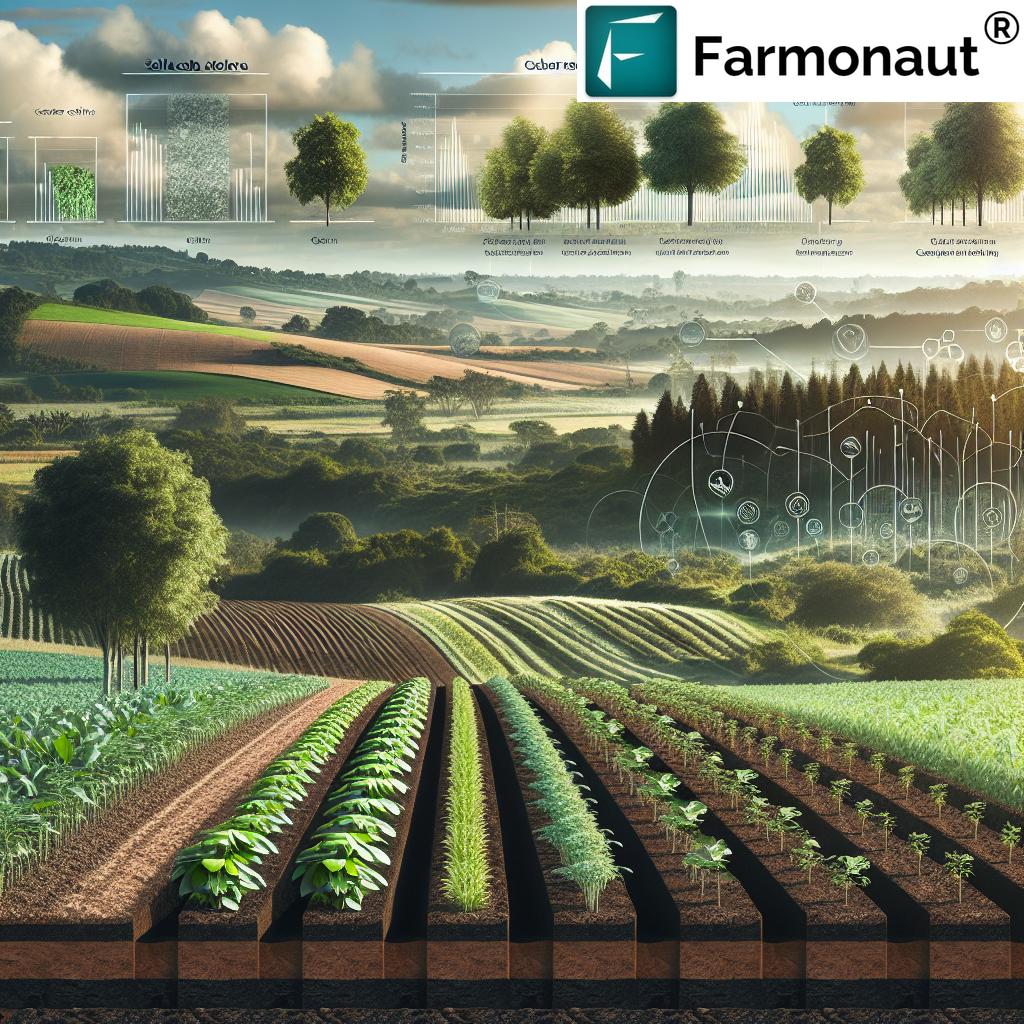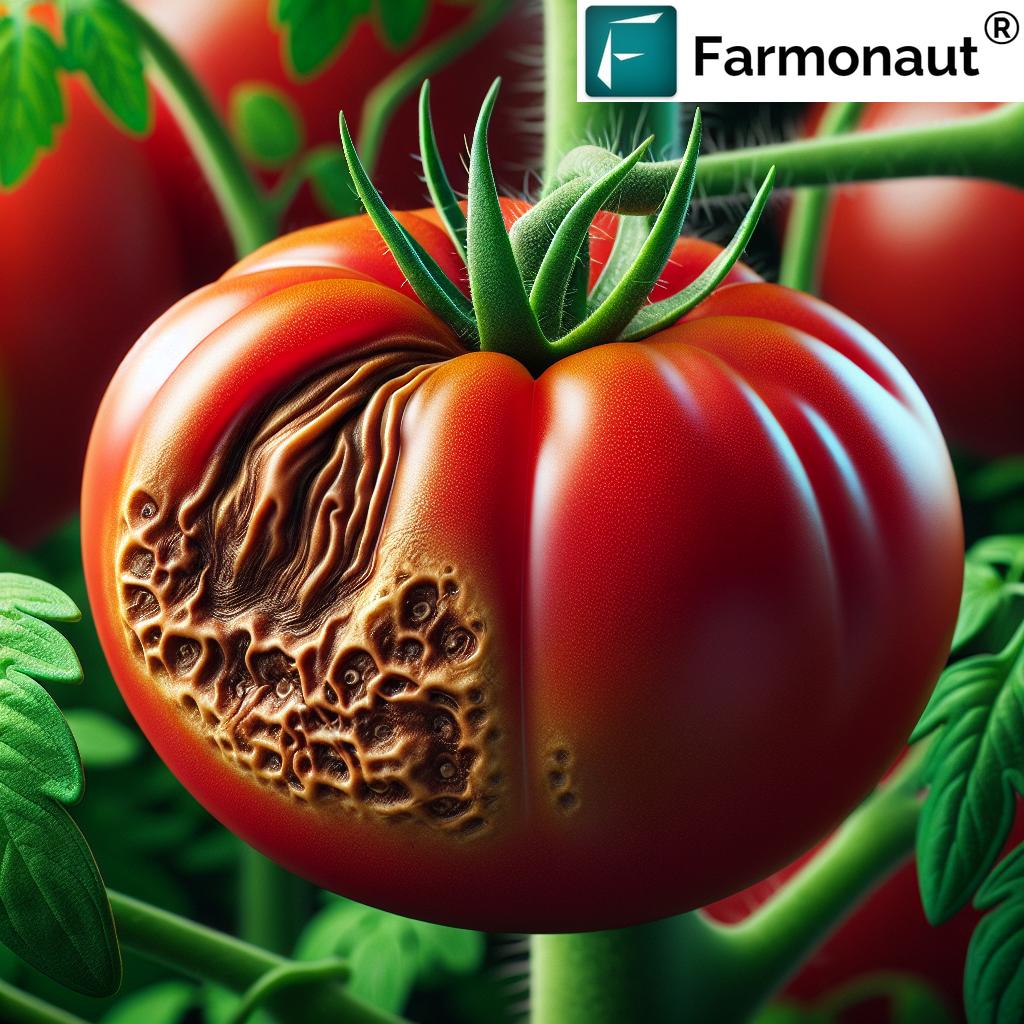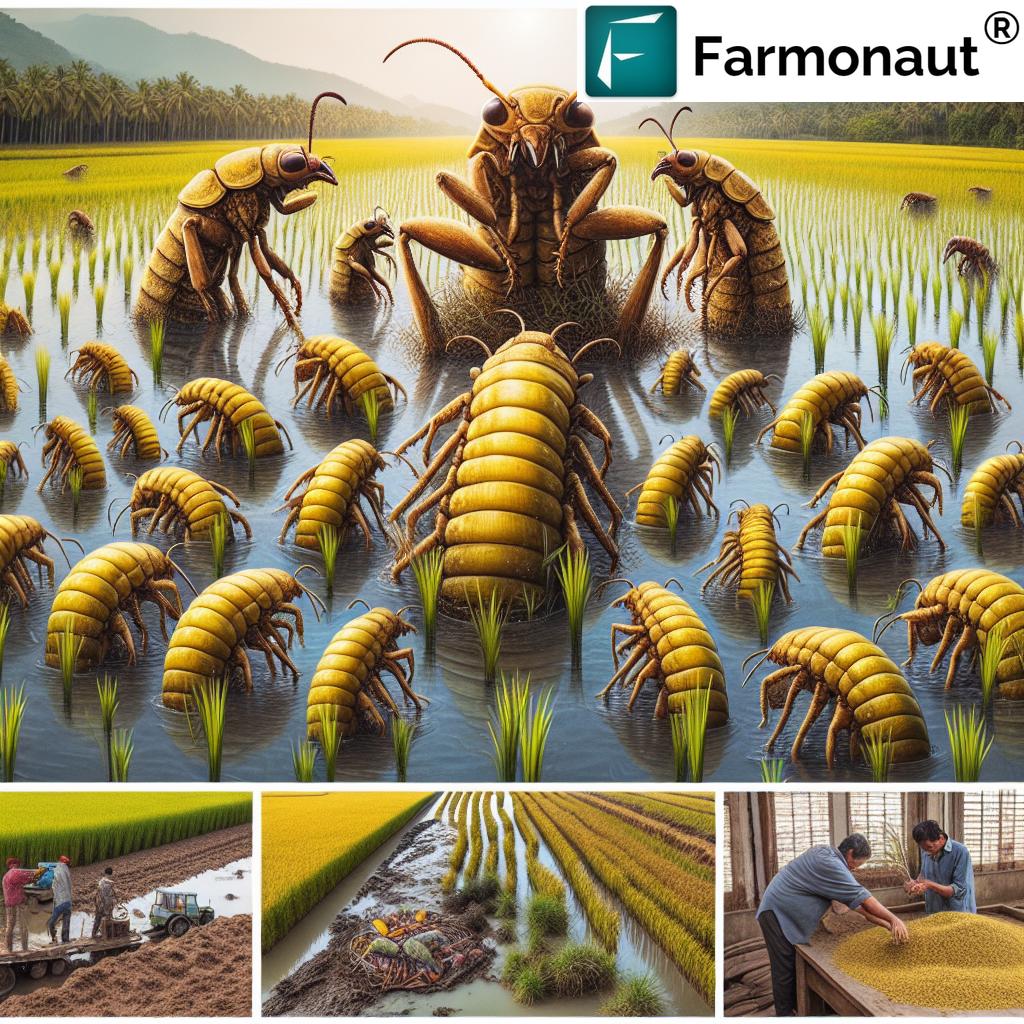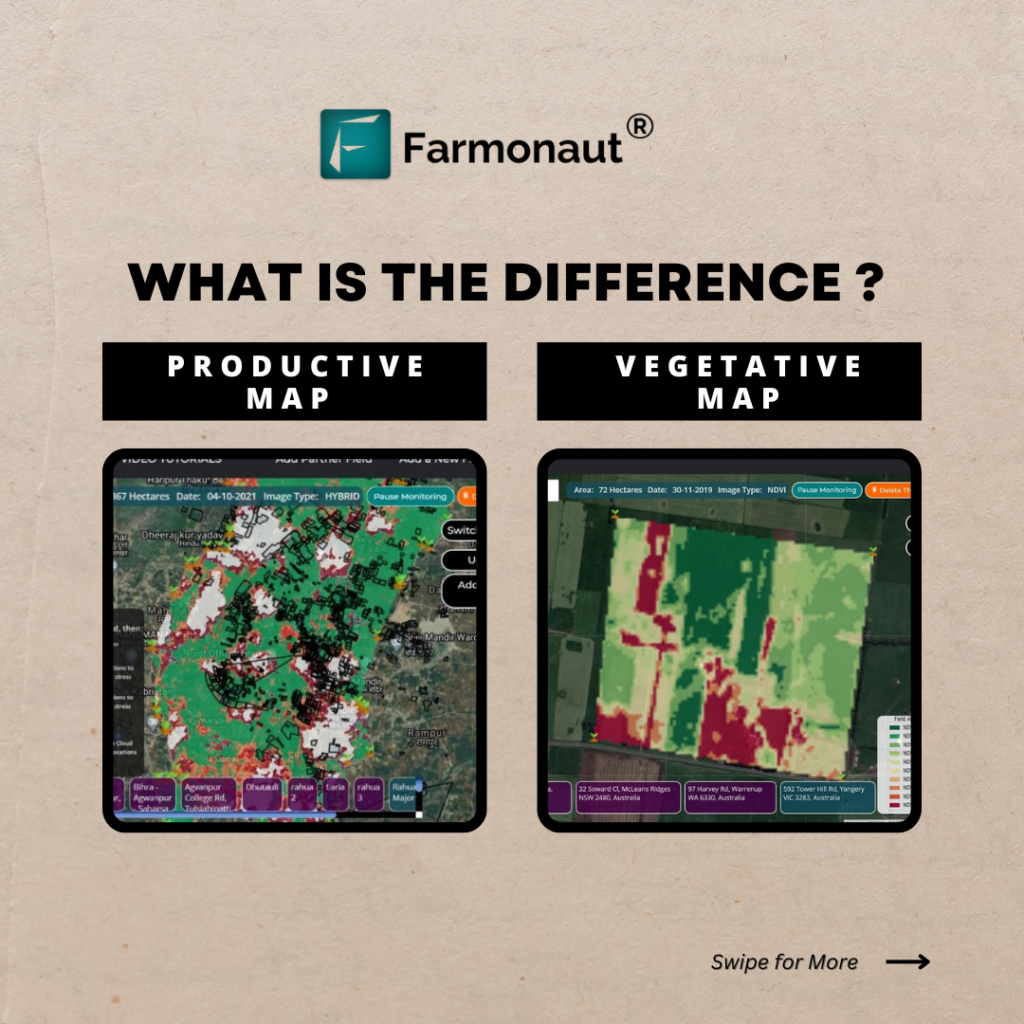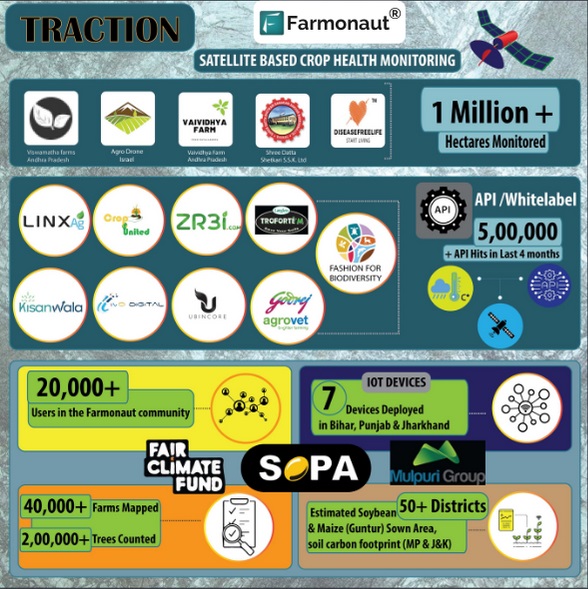
Organic vs. Chemical: Controlling Rhizoctonia Root Rot in Vegetables and Turf
At Farmonaut, we understand the challenges farmers face when dealing with plant diseases. One particularly troublesome fungal pathogen that affects a wide range of crops and turf grasses is Rhizoctonia. In this comprehensive guide, we’ll explore the impact of Rhizoctonia on various plants, including vegetables and turf, and discuss both organic and chemical treatments for effective disease control.
Understanding Rhizoctonia: A Persistent Threat to Plant Health
Rhizoctonia is a genus of fungi that causes various plant diseases, most notably root rot and damping-off in seedlings. This fungus can affect a wide range of plants, including important crops like cucumber, strawberry, beet, rice, eggplant, and pepper, as well as turf grass. The damage caused by Rhizoctonia can lead to significant economic losses for farmers and gardeners alike.
Symptoms and Impact of Rhizoctonia Infections
Rhizoctonia infections typically manifest as:
- Black or brown lesions on roots, stems, and lower leaves
- Wilting and yellowing of foliage
- Damping-off of seedlings
- Stunted growth and reduced yield
- Patches of dead or dying grass in turf
The severity of these symptoms can vary depending on the plant species, environmental conditions, and the strain of Rhizoctonia involved. Early detection and proper management are crucial for minimizing crop losses and maintaining healthy plants.
Conventional vs. Organic Approaches to Rhizoctonia Control
When it comes to managing Rhizoctonia infections, farmers and gardeners have two main options: conventional chemical treatments and organic methods. Each approach has its advantages and limitations, and the choice often depends on factors such as crop type, severity of infection, and personal or regulatory preferences.
Conventional Chemical Treatments
Chemical fungicides have long been a go-to solution for controlling Rhizoctonia and other fungal pathogens. These products offer several benefits:
- Rapid action against active infections
- Broad-spectrum protection against multiple fungal species
- Consistent performance under various environmental conditions
- Long-lasting residual activity
Some commonly used chemical fungicides for Rhizoctonia control include:
- Azoxystrobin
- Fludioxonil
- Iprodione
- Propiconazole
- Thiophanate-methyl
While effective, chemical fungicides should be used judiciously to prevent the development of fungicide resistance and minimize potential environmental impacts.
Organic Treatment Options
For those seeking more environmentally friendly solutions or adhering to organic farming practices, several organic methods can help manage Rhizoctonia infections:
- Cultural practices:
- Crop rotation with non-susceptible plants
- Proper drainage and irrigation management
- Avoiding over-fertilization with nitrogen
- Removing infected plant debris
- Biological control agents:
- Trichoderma species
- Bacillus subtilis
- Pseudomonas fluorescens
- Organic fungicides:
- Copper-based products
- Sulfur compounds
- Neem oil
- Soil amendments:
- Compost tea
- Biochar
- Mycorrhizal fungi inoculants
These organic methods often work best when used in combination as part of an integrated pest management (IPM) strategy.
Crop-Specific Strategies for Rhizoctonia Management
Different crops may require tailored approaches to effectively manage Rhizoctonia infections. Let’s explore some strategies for key crops affected by this pathogen:
Cucumbers and Other Cucurbits
Cucumber plants are particularly susceptible to Rhizoctonia, especially during the seedling stage. To protect these crops:
- Use raised beds or hills to improve drainage
- Apply organic mulches to reduce soil splashing
- Consider grafting susceptible varieties onto resistant rootstocks
- Implement drip irrigation to minimize leaf wetness
Strawberries
Strawberry plants can suffer significant losses due to Rhizoctonia crown rot. Management strategies include:
- Planting on raised beds with plastic mulch
- Using disease-free transplants
- Avoiding overhead irrigation
- Applying beneficial microorganisms to the soil before planting
Beets and Other Root Crops
Beet crops are vulnerable to Rhizoctonia root rot, which can cause significant yield losses. To protect root crops:
- Practice crop rotation with non-host plants
- Improve soil drainage through tillage and land leveling
- Apply balanced fertilization to promote strong root development
- Consider seed treatments with biological control agents
Rice
Rice crops can be severely affected by Rhizoctonia, particularly in the form of sheath blight. Management strategies for rice include:
- Using resistant varieties when available
- Implementing proper water management techniques
- Adjusting planting density to reduce humidity in the canopy
- Applying silicon-based fertilizers to enhance plant resistance
Turf Grass
Turf managers often face challenges with Rhizoctonia, which can cause brown patch disease. To maintain healthy grass:
- Avoid excessive nitrogen fertilization
- Improve air circulation by pruning nearby trees and shrubs
- Reduce thatch buildup through regular aeration
- Water deeply but infrequently to promote deep root growth
Innovative Technologies for Rhizoctonia Detection and Management
At Farmonaut, we’re at the forefront of agricultural technology, offering innovative solutions to help farmers detect and manage Rhizoctonia infections more effectively. Our satellite-based crop monitoring system provides valuable insights that can revolutionize disease management strategies.
| Aspect | Traditional Methods | Farmonaut Satellite System |
|---|---|---|
| Early Detection | Relies on visual inspection, often detecting issues after significant damage has occurred | Uses advanced spectral analysis to detect subtle changes in plant health, enabling early intervention |
| Affected Area Mapping | Manual scouting and mapping, time-consuming and potentially inaccurate | Provides precise, GPS-tagged maps of affected areas, allowing for targeted treatment |
| Precision Treatment | Often involves blanket application of treatments across entire fields | Enables targeted application of treatments only where needed, reducing costs and environmental impact |
| Cost-Effectiveness | High labor costs for manual scouting and potential overuse of treatments | Reduces labor costs and optimizes treatment application, leading to significant savings |
| Time Efficiency | Time-consuming manual inspections and data collection | Rapid, automated data collection and analysis, providing real-time insights |
By leveraging our satellite technology, farmers can:
- Detect Rhizoctonia infections before visible symptoms appear
- Map affected areas with precision for targeted treatments
- Monitor the effectiveness of control measures over time
- Optimize resource allocation for disease management
To learn more about how Farmonaut can help you manage Rhizoctonia and other plant diseases, visit our app page or explore our API documentation.
Integrated Approaches for Sustainable Rhizoctonia Management
While both organic and chemical methods have their place in Rhizoctonia control, an integrated approach often yields the best results. By combining cultural practices, biological controls, and judicious use of fungicides, farmers can create a robust defense against this persistent pathogen.
Key Components of an Integrated Rhizoctonia Management Strategy
- Soil Health Management:
- Maintain optimal soil pH and nutrient levels
- Incorporate organic matter to improve soil structure and microbial diversity
- Use cover crops to suppress pathogens and improve soil health
- Cultural Practices:
- Implement proper crop rotation schedules
- Optimize planting dates to avoid conditions favorable for disease development
- Manage irrigation to minimize leaf wetness and soil moisture
- Biological Control:
- Apply beneficial microorganisms as seed treatments or soil amendments
- Encourage natural predators of fungal pathogens
- Use biofumigation techniques with Brassica species
- Chemical Control:
- Use fungicides strategically based on disease pressure and environmental conditions
- Rotate between different modes of action to prevent resistance development
- Consider seed treatments for early-season protection
- Monitoring and Decision Support:
- Utilize Farmonaut’s satellite-based crop monitoring system for early detection
- Implement regular scouting programs to assess disease pressure
- Use predictive models to anticipate disease outbreaks
The Role of Plant Breeding in Rhizoctonia Resistance
While management practices are crucial, developing resistant plant varieties offers a long-term solution to Rhizoctonia challenges. Plant breeders are continuously working to identify and incorporate resistance genes into commercial crop varieties.
Advances in Breeding for Rhizoctonia Resistance
- Identification of quantitative trait loci (QTLs) associated with Rhizoctonia resistance
- Use of marker-assisted selection to accelerate breeding programs
- Exploration of wild relatives as sources of novel resistance genes
- Development of transgenic plants with enhanced resistance to Rhizoctonia
By planting resistant varieties when available, farmers can significantly reduce their reliance on chemical controls and improve overall crop resilience.
Environmental Considerations in Rhizoctonia Management
As we strive for more sustainable agricultural practices, it’s essential to consider the environmental impact of Rhizoctonia management strategies. Here are some key considerations:
Soil Health and Biodiversity
Maintaining a healthy, diverse soil ecosystem can naturally suppress Rhizoctonia and other pathogens. Practices that promote soil health include:
- Minimizing tillage to preserve soil structure and beneficial microorganisms
- Using diverse crop rotations to disrupt pathogen lifecycles
- Applying compost and other organic amendments to enhance soil biology
Water Quality Protection
Chemical fungicides can potentially impact water quality if not used properly. To minimize this risk:
- Follow label instructions and local regulations for fungicide application
- Implement buffer zones near water bodies
- Use precision application techniques to reduce off-target drift
Beneficial Organism Conservation
Many organisms play important roles in natural pest control and pollination. To protect these beneficial species:
- Choose selective fungicides when possible
- Time applications to minimize impact on non-target organisms
- Provide habitat for beneficial insects and microorganisms
Economic Considerations in Rhizoctonia Management
Effective Rhizoctonia management requires balancing disease control with economic sustainability. Consider the following factors when developing a management strategy:
Cost-Benefit Analysis
- Compare the costs of different control methods against potential yield gains
- Consider long-term benefits of soil health improvements
- Factor in the value of reduced chemical inputs when using integrated approaches
Risk Management
- Assess the historical disease pressure in your area
- Consider crop insurance options for high-value crops
- Diversify crop rotations to spread risk across multiple commodities
Technology Investment
- Evaluate the return on investment for precision agriculture tools like Farmonaut’s satellite monitoring system
- Consider the long-term benefits of improved decision-making and resource optimization
The Future of Rhizoctonia Management
As agricultural technology continues to advance, we can expect to see new and innovative approaches to managing Rhizoctonia and other plant diseases. Some promising areas of research include:
Gene Editing Technologies
CRISPR and other gene editing tools may allow for the rapid development of resistant crop varieties with precisely targeted genetic modifications.
Nanotechnology
Nanoparticle-based fungicides and delivery systems could provide more effective and environmentally friendly disease control options.
Artificial Intelligence and Machine Learning
Advanced algorithms could improve disease prediction models and optimize treatment recommendations based on real-time data.
Microbiome Engineering
Developing custom microbial consortia to enhance plant resistance and suppress pathogens could offer a biological alternative to chemical controls.
Conclusion: A Holistic Approach to Rhizoctonia Management
Managing Rhizoctonia effectively requires a comprehensive, integrated approach that considers the specific needs of each crop, the local environment, and the economic realities of modern agriculture. By combining traditional wisdom with cutting-edge technology, farmers can develop robust strategies to protect their crops from this persistent pathogen.
At Farmonaut, we’re committed to supporting farmers in their efforts to control Rhizoctonia and other plant diseases. Our satellite-based monitoring system provides valuable insights that can help optimize disease management strategies, reduce input costs, and improve overall crop health.
To learn more about how Farmonaut can help you manage Rhizoctonia and other plant diseases, download our app for Android or iOS, or explore our API documentation for custom integrations.
FAQs About Rhizoctonia Management
- Q: What crops are most susceptible to Rhizoctonia infections?
A: Rhizoctonia can affect a wide range of crops, but some of the most susceptible include cucumber, strawberry, beet, rice, eggplant, pepper, and various turf grasses. - Q: How can I tell if my plants have Rhizoctonia?
A: Look for symptoms such as black or brown lesions on roots and lower stems, wilting, yellowing of foliage, and damping-off in seedlings. In turf, you may see patches of dead or dying grass. - Q: Are organic methods as effective as chemical fungicides for controlling Rhizoctonia?
A: Organic methods can be effective, especially when used as part of an integrated management approach. While they may not provide the rapid control of chemical fungicides, organic methods can offer long-term benefits for soil and plant health. - Q: How can Farmonaut’s satellite monitoring help with Rhizoctonia management?
A: Our satellite technology can detect early signs of plant stress, allowing for timely intervention before visible symptoms appear. It also provides precise mapping of affected areas, enabling targeted treatments and more efficient resource use. - Q: Is it possible to completely eliminate Rhizoctonia from my fields?
A: Complete elimination of Rhizoctonia is challenging due to its ability to survive in soil and plant debris. However, with proper management strategies, you can significantly reduce its impact and maintain healthy, productive crops.
By staying informed and implementing a comprehensive management strategy, you can effectively control Rhizoctonia and protect your crops from this damaging pathogen. Remember, the key to success lies in early detection, integrated management approaches, and continuous monitoring of crop health.




